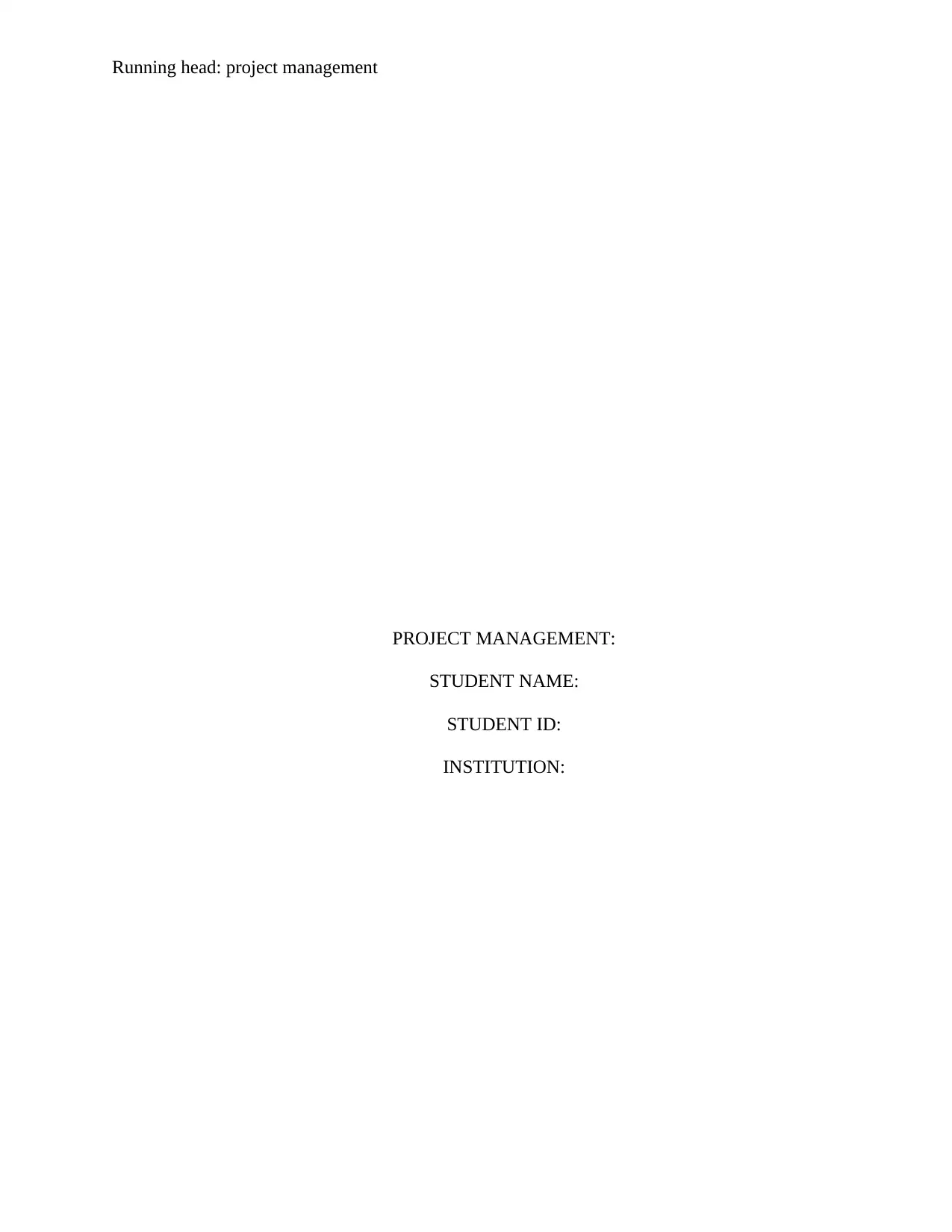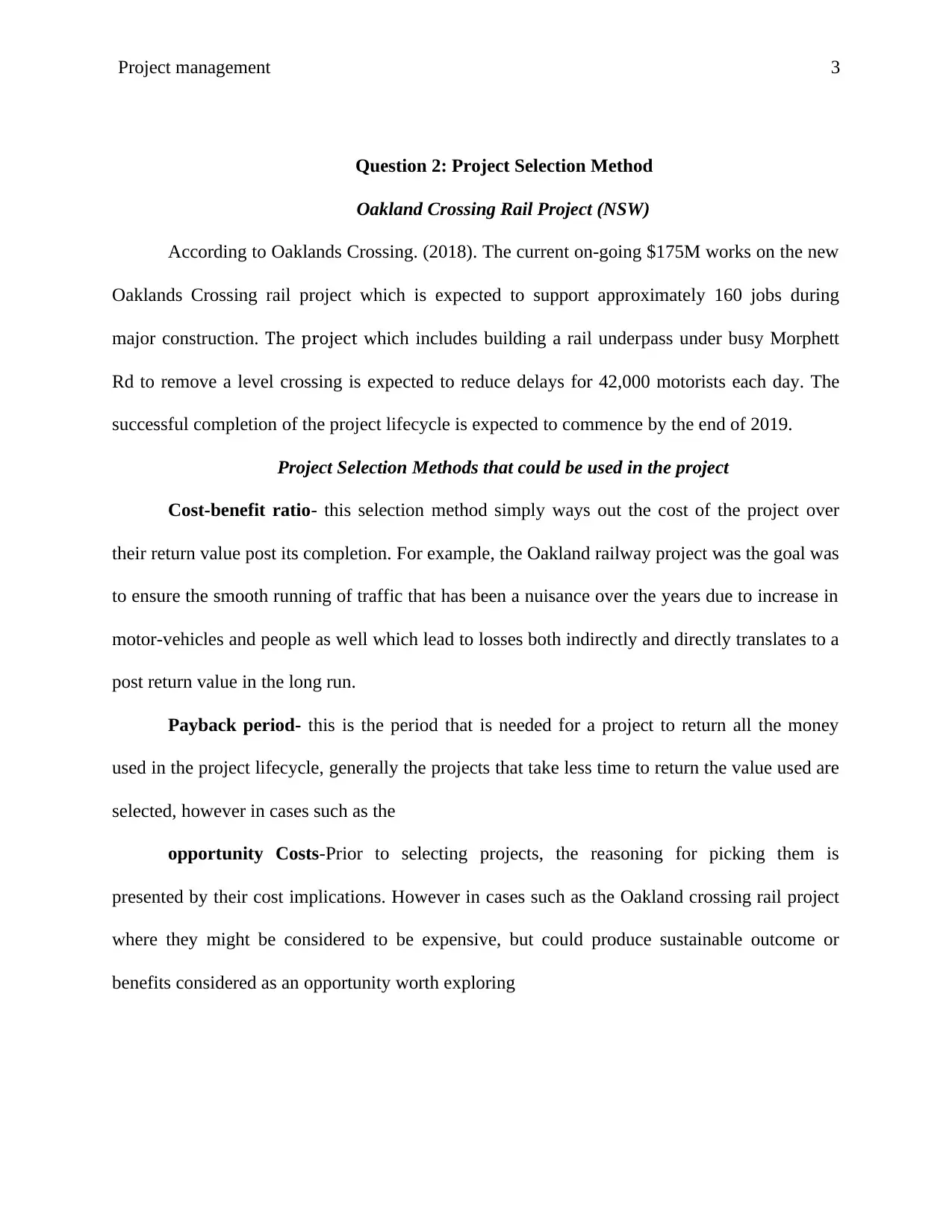Project Management Competencies and Project Selection Methods Essay
VerifiedAdded on 2023/04/10
|5
|763
|325
Essay
AI Summary
This essay discusses essential project management competencies, including effective communication, leadership, cost control, and risk management, highlighting their importance in achieving project goals. It also examines project selection methods like cost-benefit ratio and payback period, using the Oakland Crossing Rail Project in NSW as a case study. The project aims to reduce traffic delays and support job creation. The essay emphasizes the need for project managers to possess strong competencies to manage risks and ensure successful project completion, ultimately delivering quality results. Desklib offers a variety of resources, including past papers and solved assignments, to support students in their academic endeavors.

Running head: project management
PROJECT MANAGEMENT:
STUDENT NAME:
STUDENT ID:
INSTITUTION:
PROJECT MANAGEMENT:
STUDENT NAME:
STUDENT ID:
INSTITUTION:
Paraphrase This Document
Need a fresh take? Get an instant paraphrase of this document with our AI Paraphraser

Project management 2
Question 1: Project Management Competencies
Effective Communication-it is crucial and necessary for project managers to possess
effective communication so as to achieve project management goals and objectives in the long
run. Project management entails many activities such as planning and implementations which
requires the project manager to relay information accurately which gives the credibility and the
successfulness of a conducive working environment creation, which ensures the stakeholder
needs are met.
Good and effective leadership- according to DuBois, et al (2015), not only are the project
managers responsible for the successful completion of projects, but they are also responsible for
leading the team that participated in the project. Therefore, in order to manage every activity
pertaining to the project efficiently they need to portray and utilize leadership skills which can be
improved, if lacking, through training and seminars (Córdoba and Piki, 2012). This creates a
conducive working environment for the team which translates to quality results in the long run.
Effective cost control- the ability of a project manager to be in a position to run the
various activities of a project within the specified cost is among the most critical competencies a
project manager should have. This means that the managers are able to counter the various cost
mishaps that may arise during the life cycle to the project and still deliver quality results in the
end (Ramazani and Jergeas, 2015).
Risk management- a project may be prone to several constraints or risk that was unseen
by the project management team. A project manager with core competence of risk management
will play a major role in such a circumstance. Moreover, through the implementation of risk
management strategies, the project manager is able to manage the various risks which allow the
successful completion of the projects yielding quality results (Milosevic and Martinelli, 2016).
Question 1: Project Management Competencies
Effective Communication-it is crucial and necessary for project managers to possess
effective communication so as to achieve project management goals and objectives in the long
run. Project management entails many activities such as planning and implementations which
requires the project manager to relay information accurately which gives the credibility and the
successfulness of a conducive working environment creation, which ensures the stakeholder
needs are met.
Good and effective leadership- according to DuBois, et al (2015), not only are the project
managers responsible for the successful completion of projects, but they are also responsible for
leading the team that participated in the project. Therefore, in order to manage every activity
pertaining to the project efficiently they need to portray and utilize leadership skills which can be
improved, if lacking, through training and seminars (Córdoba and Piki, 2012). This creates a
conducive working environment for the team which translates to quality results in the long run.
Effective cost control- the ability of a project manager to be in a position to run the
various activities of a project within the specified cost is among the most critical competencies a
project manager should have. This means that the managers are able to counter the various cost
mishaps that may arise during the life cycle to the project and still deliver quality results in the
end (Ramazani and Jergeas, 2015).
Risk management- a project may be prone to several constraints or risk that was unseen
by the project management team. A project manager with core competence of risk management
will play a major role in such a circumstance. Moreover, through the implementation of risk
management strategies, the project manager is able to manage the various risks which allow the
successful completion of the projects yielding quality results (Milosevic and Martinelli, 2016).

Project management 3
Question 2: Project Selection Method
Oakland Crossing Rail Project (NSW)
According to Oaklands Crossing. (2018). The current on-going $175M works on the new
Oaklands Crossing rail project which is expected to support approximately 160 jobs during
major construction. The project which includes building a rail underpass under busy Morphett
Rd to remove a level crossing is expected to reduce delays for 42,000 motorists each day. The
successful completion of the project lifecycle is expected to commence by the end of 2019.
Project Selection Methods that could be used in the project
Cost-benefit ratio- this selection method simply ways out the cost of the project over
their return value post its completion. For example, the Oakland railway project was the goal was
to ensure the smooth running of traffic that has been a nuisance over the years due to increase in
motor-vehicles and people as well which lead to losses both indirectly and directly translates to a
post return value in the long run.
Payback period- this is the period that is needed for a project to return all the money
used in the project lifecycle, generally the projects that take less time to return the value used are
selected, however in cases such as the
opportunity Costs-Prior to selecting projects, the reasoning for picking them is
presented by their cost implications. However in cases such as the Oakland crossing rail project
where they might be considered to be expensive, but could produce sustainable outcome or
benefits considered as an opportunity worth exploring
Question 2: Project Selection Method
Oakland Crossing Rail Project (NSW)
According to Oaklands Crossing. (2018). The current on-going $175M works on the new
Oaklands Crossing rail project which is expected to support approximately 160 jobs during
major construction. The project which includes building a rail underpass under busy Morphett
Rd to remove a level crossing is expected to reduce delays for 42,000 motorists each day. The
successful completion of the project lifecycle is expected to commence by the end of 2019.
Project Selection Methods that could be used in the project
Cost-benefit ratio- this selection method simply ways out the cost of the project over
their return value post its completion. For example, the Oakland railway project was the goal was
to ensure the smooth running of traffic that has been a nuisance over the years due to increase in
motor-vehicles and people as well which lead to losses both indirectly and directly translates to a
post return value in the long run.
Payback period- this is the period that is needed for a project to return all the money
used in the project lifecycle, generally the projects that take less time to return the value used are
selected, however in cases such as the
opportunity Costs-Prior to selecting projects, the reasoning for picking them is
presented by their cost implications. However in cases such as the Oakland crossing rail project
where they might be considered to be expensive, but could produce sustainable outcome or
benefits considered as an opportunity worth exploring
⊘ This is a preview!⊘
Do you want full access?
Subscribe today to unlock all pages.

Trusted by 1+ million students worldwide

Project management 4
References
Córdoba, J. R., & Piki, A. (2012). Facilitating project management education through
groups as systems. International Journal of Project Management, 30(1), 83-93.
DuBois, M., Koch, J., Hanlon, J., Nyatuga, B., & Kerr, N. (2015). Leadership Styles of
Effective Project Managers: Techniques and Traits to Lead High Performance
Teams. Journal of Economic Development, Management, IT, Finance &
Marketing, 7(1).
Kaiser, M. G., El Arbi, F., & Ahlemann, F. (2015). Successful project portfolio
management beyond project selection techniques: Understanding the role of
structural alignment. International Journal of Project Management, 33(1), 126-
139.
Milosevic, D. Z., & Martinelli, R. J. (2016). Project management toolbox: tools and
techniques for the practicing project manager, 3(1), 83-93. John Wiley & Sons.
Oaklands Crossing. (2018). Retrieved March 20, 2019, from
https://www.infrastructure.sa.gov.au/public_transport_projects/oaklands_crossing
Ramazani, J., & Jergeas, G. (2015). Project managers and the journey from good to great:
The benefits of investment in project management training and
education. International Journal of Project Management, 33(1), 41-52.
Wang, W., Zhong, M., & Hunt, J. D. (2019). Analysis of the Wider Economic Impact of
a Transport Infrastructure Project Using an Integrated Land Use Transport
Model. Sustainability, 11(2), 364.
References
Córdoba, J. R., & Piki, A. (2012). Facilitating project management education through
groups as systems. International Journal of Project Management, 30(1), 83-93.
DuBois, M., Koch, J., Hanlon, J., Nyatuga, B., & Kerr, N. (2015). Leadership Styles of
Effective Project Managers: Techniques and Traits to Lead High Performance
Teams. Journal of Economic Development, Management, IT, Finance &
Marketing, 7(1).
Kaiser, M. G., El Arbi, F., & Ahlemann, F. (2015). Successful project portfolio
management beyond project selection techniques: Understanding the role of
structural alignment. International Journal of Project Management, 33(1), 126-
139.
Milosevic, D. Z., & Martinelli, R. J. (2016). Project management toolbox: tools and
techniques for the practicing project manager, 3(1), 83-93. John Wiley & Sons.
Oaklands Crossing. (2018). Retrieved March 20, 2019, from
https://www.infrastructure.sa.gov.au/public_transport_projects/oaklands_crossing
Ramazani, J., & Jergeas, G. (2015). Project managers and the journey from good to great:
The benefits of investment in project management training and
education. International Journal of Project Management, 33(1), 41-52.
Wang, W., Zhong, M., & Hunt, J. D. (2019). Analysis of the Wider Economic Impact of
a Transport Infrastructure Project Using an Integrated Land Use Transport
Model. Sustainability, 11(2), 364.
Paraphrase This Document
Need a fresh take? Get an instant paraphrase of this document with our AI Paraphraser

Project management 5
1 out of 5
Related Documents
Your All-in-One AI-Powered Toolkit for Academic Success.
+13062052269
info@desklib.com
Available 24*7 on WhatsApp / Email
![[object Object]](/_next/static/media/star-bottom.7253800d.svg)
Unlock your academic potential
Copyright © 2020–2025 A2Z Services. All Rights Reserved. Developed and managed by ZUCOL.





